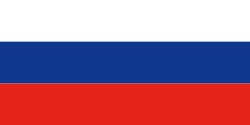Flag of Slovenia
Flag of Slovenia
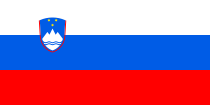 |
|
| Use |
National flag and naval ensign  |
| Proportion |
1:2 |
| Adopted |
1991 |
|
 |
| Variant flag of Slovenia |
| Use |
Civil and state ensign  |
| Proportion |
2:3 |
| Adopted |
1991 |

Presidential Standard
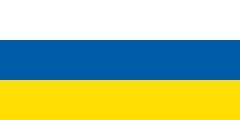

Naval jack. Flag ratio: 1:2
The national flag of Slovenia features three equal horizontal bands of white (top), blue, and red, with the Slovenian coat of arms located in the upper hoist side of the flag centered in the white and blue bands. The coat of arms is a shield with the image of Mount Triglav, Slovenia's highest peak, in white against a blue background at the centre; beneath it are two wavy blue lines representing the Adriatic Sea and local rivers, and above it are three six-pointed golden stars arranged in an inverted triangle which are taken from the coat of arms of the Counts of Celje, the great Slovenian dynastic house of the late 14th and early 15th centuries [1].
The flag's colours are considered to be Pan-Slavic, but they actually come from the medieval coat of arms of the Duchy of Carniola, consisting of a blue eagle on a white background with a red-and-gold crescent. The colors of the flag were considered national colours before they were first arranged on a flag during the rise of nationalism in Europe. The existing tricolour was created during the Spring of Nations in 1848[2], when a group of students from Ljubljana took the colours from the Carniolan coat of arms, arranging them in such a way that it resembled the Russian national flag.
The civil and state ensign for ships has the same design as the national flag, but a different shape (2:3 instead of 1:2). (Boats up to 24 meters use the national flag as an ensign.[3]) The naval jack is a white, blue, and yellow horizontal tricolor[4].
Historical development
Origins
The white-blue-red Slovenian flag was first exposed on April 7, 1848, on a building between the Congress Square and the Prešeren Square in Ljubljana, by a group of nationally minded students led by the renowned national conservative activist and poet Lovro Toman. Despite opposition from the local Ethnic Germans it was subsequently recognized by the Austrian Government as the official flag of Carniola. This formal recognition, albeit on a regional level, was an exception to the policy of the Austrian Government which tended to persecute national symbols of the single nationalities in the Empire. In addition, Austrian authorities saw all tricolours as basically nationalist and potentially revolutionary symbols, so Austrian provinces (as the Empire itself) were only allowed to use bicolours (the only exception being the flag of the Kingdom of Croatia and Slavonia, since it was interpreted to be a combination of the Croatian and Slavonian bicolours). So the official recognition of the Carniolan white-blue-red tricolour instead of the traditional white-blue bicolour was seen as a major achievement by the Slovenes and it quickly became the symbol representing the idea of United Slovenia. In the second half of the 19th century, the Slovenian national tricolur became the only truly all-Slovenian symbol, representing all Slovenes, regardless of the historical region in which they lived.
National flag of Slovenians in the Kingdom of Yugoslavia
The tricolor flag continued to be associated with Slovenia during the country's incorporation into Yugoslavia. In the interwar period, it was also used by the Slovenians of the Julian March that were annexed to Italy, where it was prohibited and persecuted by the fascist regime.
Slovenian flag during and after WWII
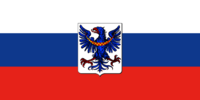
Flag of the Slovene Home Guard, Slovenian
Nazi-sponsored anti-communist militia, with the traditional coat of arms of
Carniola
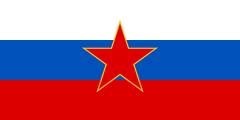
Flag of SR Slovenia, 1945-1991
During World War II The Slovene national colours were used both by the Partisan Resistance Movement (usually with a red star in the middle) and by the Slovenian Home Guard, the voluntary anti-Communist militia sponsored and supporting by the Nazi German occupation forces.
In 1945 a red star was officially placed on the flag of the Socialist Republic of Slovenia, a constituent of the Socialist Yugoslavia.
Flag of independent Slovenia
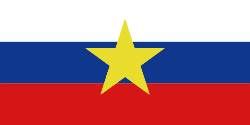
Flag Proposal in 1990 before independence by the Party of Democratic Reform
Following Slovenian independence from Yugoslavia, the red star was removed and the new coat of arms, designed by Marko Pogačnik, was added. The flag was officially adopted on June 27, 1991, following a long and controversial dispute about the coat of arms of the new Republic.
New flag proposals
In 2003, a campaign started to partially or completely alter the flag in order to enhance Slovenia's international recognition, and especially to differentiate it from Slovakia and its flag. An eleven-striped design won the official contest[5]. Public opinion seems to be strongly against changing the flag at the moment.
Ministry flag
| Flag |
Date |
Use |
Description |
|
1991-Present |
Slovenian Ministry of Internal Affairs |
|
|
1991-1994 |
Slovenian Territorial Defence |
|
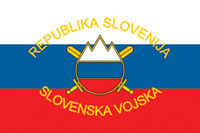 |
1994-Present |
Military of Slovenia |
|
Colours
| Scheme |
Blue |
Red |
Yellow |
White |
| CMYK |
100, 60, 0, 10 |
0, 100, 100, 0 |
0, 10, 100, 0 |
0, 0, 0, 0 |
| SCOTDIC Code 777—Int'l Colour Codification System (2034) |
N46 N722509 |
N23 N074014 |
N6 N197512 |
N1 N95 |
| *Source: http://www.ukom.gov.si/eng/slovenia/insignia/flag/ Government Communication Office |
References
External links
|
National flags and coats of arms |
|
| National flags |
Sovereign states · Dependent territories · States with limited recognition · Micronations · Stateless
|
|
| National coats of arms |
Sovereign states · Dependent territories · States with limited recognition · Micronations · Stateless
|
|
 Slovenia topics Slovenia topics |
|
| History |
Timeline · Noricum/Pannonia · Slavic settlement of the Eastern Alps · Samo's Realm · Carantania · March of Carniola · Windic March · Illyrian Provinces · Kingdom of Illyria · Duchy of Carniola · Drava Banovina · Socialist Republic of Slovenia
|
 |
|
Politics and
government |
President · Prime Minister · Parliament · National Council · National Assembly · Court of Audit · Political parties · Elections · Constitution · Constitutional Court · Law · Judiciary of Slovenia · Foreign relations · Human rights (LGBT rights)
|
|
| Geography |
Statistical regions · Municipalities · Conservation · Districts and places · Fauna · Flora · Lakes · Mountains · Parks · Reservoirs · Rivers · Cities, towns and villages · Waterways · Urban planning
|
|
| Economy |
History · Taxation · Ministry of the Economy · Companies · Banks · Bank of Slovenia · Ljubljana Stock Exchange · International rankings
|
|
| Demographics |
Slovenes (list) · Slovene language · Education · Hungarians · Italians · Croats · Serbs · Macedonians · Roma in Slovenia · The Erased · Religion · Human rights · Social issues
|
|
| Culture |
Architecture · Cinema · Cuisine · Education · Languages · Literature · Music · Public holidays · Radio · Television
|
|
| Transport |
Roads · Ljubljana Jože Pučnik Airport · Adria Airways · Buses · Driving · Rail · Aviation · Port of Koper
|
|
| Symbols |
|
|
| Other topics |
Communications · Future developments in Slovenia · Military · Police · Sports · Tourism
|
|
| Portal · Topics |
|




